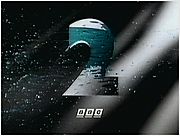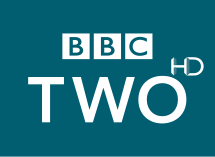BBC Two facts for kids

Logo used since 2021
|
|
| Country | United Kingdom |
|---|---|
| Broadcast area |
|
| Network | BBC Television |
| Headquarters | Broadcasting House |
| Programming | |
| Language(s) | English |
| Picture format | |
| Ownership | |
| Owner | BBC |
| Sister channels | |
| History | |
| Launched | 21 April 1964 |
| Former names | BBC2 (21 April 1964 – 4 October 1997) |
| Links | |
| Webcast | BBC Two on BBC iPlayer (UK only) |
| Availability | |
| Terrestrial | |
| Freeview | Channel 2 (SD) Channel 102 (HD) |
| Other providers | See dedicated section |
BBC Two is a British television channel run by the BBC. It's a "public service" channel, meaning it's made for everyone and funded by the television licence fee, not by adverts. This allows BBC Two to show a wide variety of programmes, including comedy, drama, and documentaries. It's known for showing more in-depth and serious programmes compared to BBC One, which focuses on more popular shows.
BBC Two was the third TV channel to start in Britain, launching on 21 April 1964. It was also the first channel in Europe to regularly broadcast in colour, starting on 1 July 1967. The channel was created to offer different kinds of shows, often more ambitious or for special interests. While some of these special programmes now appear on BBC Four, BBC Two still aims to provide unique and thoughtful content.
Contents
History of BBC Two
Learn about how BBC Two started and how it changed over the years.
Starting the Channel
Before BBC Two, Britain only had two TV channels: the BBC Television Service (now BBC One) and the ITV network. Both channels tried to attract the most viewers with popular shows. A report in 1962 suggested that Britain needed a third TV channel, and it should be given to the BBC to offer more cultural programmes.
BBC2, as it was called then, was supposed to start on the evening of 20 April 1964. However, a big power cut in London stopped the launch. BBC One could still broadcast from a different location, but the new BBC2 couldn't. Programmes were officially postponed until the next morning.
The very first official programme shown on BBC2 was Play School on 21 April 1964. To make up for the power cut, the evening's shows started with a presenter jokingly blowing out a lit candle.
To help the new channel become popular, the BBC showed a grand series called The Forsyte Saga in 1967. This show was very successful, with millions of people watching it. This helped BBC2 become a well-known channel.
New Technology and Colour TV
Unlike BBC One and ITV at the time, BBC2 was the first channel to use a newer broadcasting system called 625-line UHF. This meant that older TVs couldn't receive BBC2 unless they were updated.
A big moment for BBC2 was on 1 July 1967, when it became the first channel in Europe to regularly broadcast in colour. This happened during the Wimbledon tennis tournament. To show off the new colour technology, a special series called Civilisation was created. Later, BBC One and ITV also started broadcasting in colour.
In 1979, BBC2 was also the first British channel to use a computer-generated logo. This orange '2' logo was very modern for its time and was used for many years. As Britain switched to digital TV, BBC Two was often the first analogue channel to be turned off in each area, making way for digital services.
In 2012, BBC Two was named "Terrestrial Channel of the Year" at a big TV festival. A high-definition (HD) version of BBC Two, called BBC Two HD, started broadcasting on 26 March 2013, offering a much clearer picture.
How BBC Two Works
BBC Two is part of the BBC Television group. It has leaders who decide what programmes to show. For example, David Attenborough was the channel controller from 1965 to 1969. Since 2020, the BBC has changed how its channels are managed, moving to a system where leaders focus on different types of programmes, like factual shows, instead of just one channel.
Programmes on BBC Two
BBC Two aims to show a wide range of programmes for adults, with a focus on depth and quality. It's known for having many educational and factual shows, as well as unique comedy, drama, and arts programmes.
Historically, BBC Two has been famous for its award-winning drama series, like Boys from the Blackstuff and Our Friends in the North. It also has a long history of showing detailed documentaries, such as Civilisation and The Ascent of Man. The channel also used to show many independent and international films.
Sometimes, programmes that become very popular on other BBC channels, like BBC Three or BBC Four, move to BBC Two for their next series. For example, the sci-fi show Torchwood moved to BBC Two after its first series. Also, popular comedies like Absolutely Fabulous and Miranda started on BBC Two before moving to BBC One. The Great British Bake Off also moved from BBC Two to BBC One, and then later to Channel 4.
BBC Two has also played a big role in educational TV. It used to broadcast many programmes for the Open University, which helps people learn from home. It also showed programmes for schools for many years. The channel also had special series where ordinary people could make their own films about topics important to them.
Many international shows have also been shown for the first time in the UK on BBC Two. These include popular series like M*A*S*H, The Simpsons, 24, Family Guy, and The Fresh Prince of Bel-Air.
In 2013, BBC Two stopped showing children's programmes during weekday mornings, replacing them with repeats of BBC One daytime shows. However, children's programmes returned on Saturday mornings in 2017 and 2022.
BBC Two also broadcasts news and current affairs programmes. Every weekday morning, it shows updates from the BBC News channel. It also has a political debate show called Politics Live and a late-night current affairs programme called Newsnight, which looks deeper into the day's headlines.
Sometimes, if BBC One is showing a special news report, like a government press conference, the programmes that were supposed to be on BBC One will be moved to BBC Two instead.
Channel Look and Logos
BBC Two has changed its on-screen look and logos many times over the years.
In 1991, BBC Two introduced a famous set of on-screen animations, called "idents," which featured a number '2' in different artistic scenes. These were very popular. In 2001, the channel changed its look again, giving the '2' a "personality" on a yellow background.
In 2007, BBC Two launched a new theme called "Window on the World," where the '2' shape acted as a window to different scenes. In 2014, for the channel's 50th birthday, some of the old 1990s idents were brought back.
Since 2018, BBC Two has used new idents that feature curved shapes resembling the number 2. These new looks are created by different artists and studios, including Aardman Animations, known for Wallace & Gromit.
Regional Versions
BBC Two also has different versions for Wales and Northern Ireland. These regional channels sometimes show programmes that are specifically for people in those areas, instead of the national BBC Two feed. For example, BBC Two Scotland used to exist, but it was replaced by a new BBC Scotland channel in 2019.
How to Watch BBC Two
BBC Two is available on most TV services in the UK.
On Your TV
- Freeview: Channel 2 (standard definition) and Channel 102 (high definition).
- Freesat: Channel 102 (HD).
- Sky: Channel 102 (HD).
- Virgin Media: Channel 102 (HD).
- Sky Glass: Channel 102 (HD).
- Freely: Channel 2 (HD).
Watching Outside the UK
The Northern Irish version of BBC Two can be watched in the Republic of Ireland through satellite and cable. The main BBC Two channel is also available on cable and internet TV services in some European countries like the Netherlands and Switzerland.
Since 2013, BBC Two has also been available through the British Forces Broadcasting Service (BFBS) for UK military families around the world.
Making TV Accessible
The BBC works hard to make its programmes available to everyone.
- All programmes on BBC Two have subtitles for people who are deaf or hard of hearing. You can usually turn these on using the BBC Red Button.
- Some popular programmes also have audio description for viewers who are visually impaired. This describes what is happening on screen.
- British sign language interpretation is also available on some programmes for deaf viewers.
BBC Two HD
Before 2013, high-definition (HD) versions of BBC Two programmes were shown on a separate channel called BBC HD. However, to save money, BBC HD was closed. On 26 March 2013, it was replaced by BBC Two HD, which shows the same programmes as BBC Two but in much clearer high definition.
Since 2018, regional versions of BBC Two HD have also launched in Wales and Northern Ireland, allowing viewers in those areas to watch their local programmes in HD.
More to Explore
- History of BBC television idents
- List of television stations in the United Kingdom
See also
 In Spanish: BBC Two para niños
In Spanish: BBC Two para niños








